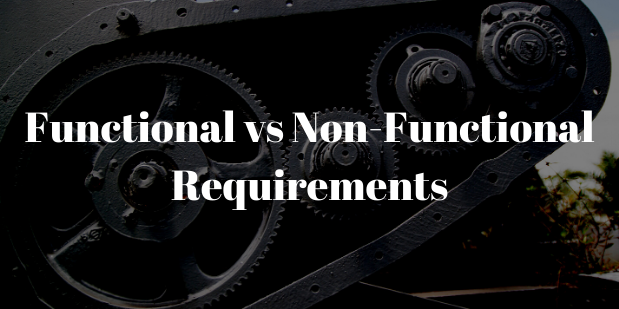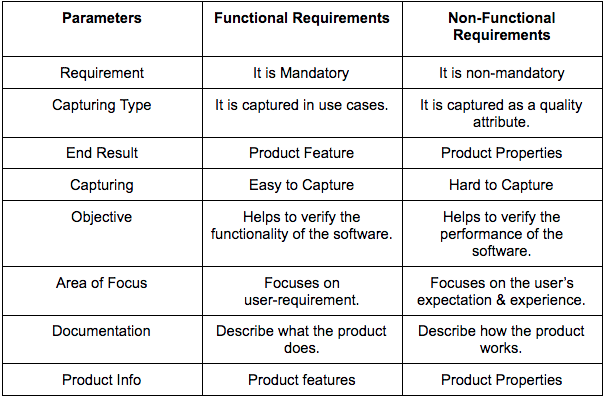Functional vs Non-Functional Requirements: Main Differences & Examples

Just imagine you want to build a two-storey house. You have defined a few specifications like it must have a red roof, along with several windows. But there are many such other specifications that you must define like number of rooms, the color on the walls and what style of the house you want. Should it be mid-century modern or even house? So you need to clarify many aspects to make the result meet your requirements.
And the same is applied to mobile app development as it needs a detailed vision of every project to get a seamless app development. On the other hand, if the team needs to clarify information during the development stage, development time & costs might increase and the time it will take to get the app developed.
How can we Avoid This?
By defining functional & non-functional requirements for the project. Usually functional requirements are clear, but some of the non-functional requirements are very hard to specify. So, we need to know what acceptable performance should look like? And how can we define maintainability before any code has been written? If you want to decrease the project’s cost, increase the development of team productivity, and develop a successful and cost effective project read on. So, the handy tips on how to specify non-functional requirements.
How Requirements Impact the Software Development Process?
If the requirements are clear then the project will be a guaranteed success. It not only makes the process easy for the development team but also for the client as they’ll know that team is working to reach the same goals. If you fail to define the requirements may cause miscommunication between the team and client, and increase the chances of the project failing.
->70% of the projects with effective communication, & precise requirements definitely deliver the project on time with quality standards successfully.
->32% of IT projects failed due to estimation of the planning phase and due to unclear requirements.
->The unclear requirements are the sole reason to increase the project timeline and budget upto 60%.
->The unclear requirements consume over 40% of the IT development budget that include software, staff, and external professional services.
The detailed functional & nonfunctional requirements is mobile app development help the team to complete the following tasks:
Define the Terms & Roles – Once you define the terms & role it helps you to ensure that the development team and the business teams are on the same page and clear the avoid misunderstandings in the future while app development.
Reduce Communication Time – With a close cooperation with the Business team ensures clearer requirements in less development time. With this approach time required for communication during the mobile app development also reduces and cost more accurately.
Helped with Possible Mistakes Beforehand – When the team visualizes the project details during the discovery phase, they may identify errors in the initial stage of development. As it helps in saving your time & budget.
Create More Predictable Projects – With high-quality requirements and wireframes help in prediction of results and also in developing the project that meets your expectations.
Classification of Requirements
To turn your Business idea into a working solution, you need to clarify the following things:
Stakeholder/Client Requirements – It helps to find what you can expect from a particular solution.
Business Requirements – It includes high-level statements of goals, objectives, and needs of your project.
Solution Requirements – It helps in describing the product characteristics that will meet your expectations, client and business needs.
->Functional Requirements – Help with the description of ways a product must behave.
->Non-functional Requirements – It is also known as quality attributes, and helps in describing the general software characteristics.
Functional vs Non-Functional Requirements: The Comparison Table
Functional Requirements
These requirements describe system behavior under specific conditions and include product features and functions which web and app developers should add to the solution. Such requirements are really important for the development team and the client side. Her we have a list of examples of functional requirement includes:
a.Business Rules
b.Administrative Functions
c.Corrections in transaction, cancellations and adjustments
c.Authorization levels
d.Authentication
e.External Interfaces
f.Audit Tracking
g.Historical data
h.Reporting Requirements
i.Certification Requirements
Functional Requirements Specification Document
The documentation includes the description in details of the product’s functioning and capabilities. These could be a single functional requirements document or other documents, such as user stories and use cases. Let us have a look at the specification documents should consist of:
Overall Description – The description must include product vision, business rules and assumptions.
Purpose – This section must include background, definitions and system overview.
Specific Requirements – This must include database requirements, system attributes, and other functional requirements.
Use Cases
Use cases describe the interaction between the system and external users that leads to achieving particular goals. Each use case includes three main elements.
->Actors are the users who will interact with your product.
->System functional requirements describe the intended behavior of the product.
->Goals describe all interactions between the users and the system.
User Stories
User stories are documented descriptions of software features from the end-user perspective. The document describes scenarios of how the user engages with the solution.
Functional Decomposition
It helps by illustrating how complex processes and features break into simpler components. With the WBS approach, the team can analyze each part of the project while capturing the full project picture. There are two types of prototypes to look into. First one are the throwaway prototypes that are cheap but fast visual representations of requirements. The second one are evolutionary prototypes, more complex ones, that can later even become the early versions of the product or the MVP.
Non-Functional Requirements Examples
What is a non Functional Requirement?
It can be defined as the quality attributes that describe ways in which your product should behave. The list of basic non-functional requirement includes:
Usability
It is the degree of ease with which the user will be able to interact with your products to achieve required goals effectively & efficiently.
Legal or Regulatory Requirements
It describes the product adherence to laws, if your product violates these regulations then it can result in legal punishment and federal fines.
Reliability
Such a metric shows the possibility of your solution to fail. To achieve high reliability, your team should eliminate all bugs that may influence the code safety and issues with the system.
Performance
It helps you to know whether your solution behaves with users in different scenarios. If you have poor performance then it may lead to negative user experience and system safety.
As we have mentioned, some non-functional requirements are not so clear and might be missed by the team, clients or stakeholders and it is mainly caused by:
Subjective Nature: It allows different users to view, interpret, and evaluate non-functional characteristics in different ways.
Integrated Nature: The goals of one non-functional requirement may conflict with another since they typically have a broad effect on systems.
Don’t know what they are – The unclear terminology, confusing definitions, and the absence of classification scheme makes understanding of non-functional requirements a challenge.
Assuming that “Everybody Knows” – Both the client and the team might forget about some non-functional requirements as there is something that are hard to define from the perspective of a business idea as they might arise only after the project release. Still non-functional requirements mark the difference between a development project’s success and it’s failure.
How to define non-functional requirements?
Use a Defined Classification – You can use a defined classification and classify them into three groups like revision, operation, and transition. With this the stakeholders and the development team build a consistent language even for non-functional needs.
With a list of predefined Elicitation Questions – You may increase the development teams productivity. Besides, you can save time when preparing for elicitation interviews & workshops.
Engage with the development Team – It also helps with the requirements definition to ensure that you are on the same page with the development team.
Use Invented Wheels – You can use the invented wheels and even reuse the requirements definition to ensure that you are on the same page with the development team.
Use of Automated Testing Tools – With the use of automated tools like Selenium, TestComplete, & Appium. Such tools will help to check your product performance faster and reveal more non-functional requirements.
Precise functional & non-functional requirements are essential to reduce development costs, to make requirements clear, so the team can develop the project with ease and in a much faster way.
Functional Requirements are very easy to define for business ideas to drive them. They include all the features of your future project and ways users engage with it.
On the other hand, experience drives non-functional requirements. In order to identify them, your need to analyze the product performance in order to make it convenient and useful. Such requirements may appear when the product is being used on a regular basis.
So we can say that functional requirements describe what the system does & non-functional requirements describe how the system works.
Read More: VerveLogic
# How Much Does It Cost to Make an App
# How to Hire iOS App Developer
# Tinder Alternatives: Best Dating Apps Like Tinder 2020
# How to Outsource Mobile App Development
# Big Data and Machine Learning





